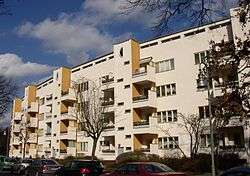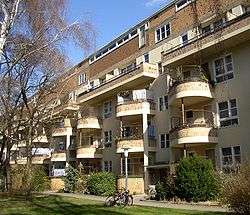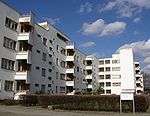Großsiedlung Siemensstadt
The Siemensstadt Settlement (German: Großsiedlung Siemensstadt; also known as Ring Settlement or Ringsiedlung) is a nonprofit residential community in the Charlottenburg-Wilmersdorf district of Berlin. It is one of the six Modernist Housing Estates in Berlin recognized in July 2008 by UNESCO as a World Heritage Site.


by Hugo Häring
Geography
Despite its name, the larger part of the estate is situated within the locality (Ortsteil) of Charlottenburg-Nord, only the smaller westernmost part belongs to Siemensstadt in the district of Spandau.
History
It was built between 1929 and 1931, under the overall master plan of German architect Hans Scharoun. Six prominent Weimar-era architects took part: Hans Scharoun, Fred Forbat, Otto Bartning, Walter Gropius, Paul Rudolph Henning, and Hugo Häring. The nickname Ringsiedlung came from the association of some of these architects with Der Ring collective.
The open spaces were designed by the German modernist landscape architect Leberecht Migge.
Unlike the other significant public housing projects of the time, which were produced under government cooperative Gehag sponsorship, the Siemensstadt was constructed by a private housing cooperative as worker housing for Siemens' nearby electrical factory, which employed 60,000 workers. The streets and squares of the settlement were named for engineers, physicists and inventors whose performance contributed to the success of Siemens AG.
The shape of the settlement marked a turning point in urban thinking, the point at which Berlin's city planner Martin Wagner abandoned a low-rise, garden city-style project with individual gardens, in favor of much denser multi-story apartment blocks.
Special offers
Distributed within the whole settlement are information columns that give short, concise information on the architects and his buildings (currently in German language only). Situated at the southern end of the Fred Forbat buildings, at Goebelstr. 2, is the so-called "Infostation Siemensstadt". This unusual shaped building was originally the shop of the settlement and supplies detailed information booklets of all six Berlin UNESCO settlements. The premises are used as showrooms by the photographer Christian Fessel. He allows access to the wall mounted model of the settlement and the information material whenever he is working in the "Infostation". Unfortunately, there are no fixed opening hours but it is tried to open voluntarily on Saturdays 1-7pm. Regular guided tours are offered by Mann.mit.Hut.Touren[1] only.
Images
 "Panzerkreuzer (armoured ship)" by Hans Scharoun
"Panzerkreuzer (armoured ship)" by Hans Scharoun „Langer Jammer (Long Misery)“
„Langer Jammer (Long Misery)“
by Otto Bartning Postwar eastern termination (1956)
Postwar eastern termination (1956)
by Hans Scharoun
See also
References
External links
| Wikimedia Commons has media related to Großsiedlung Siemensstadt. |
- Mann.Mit.Hut.Touren, English language tours on request.
- New York Times, Visionary Design for Berlin's Workers, J.S. Marcus, June 6, 1993
- City of Berlin website on the project, in English
- Siemensstadt Estate on Architectuul